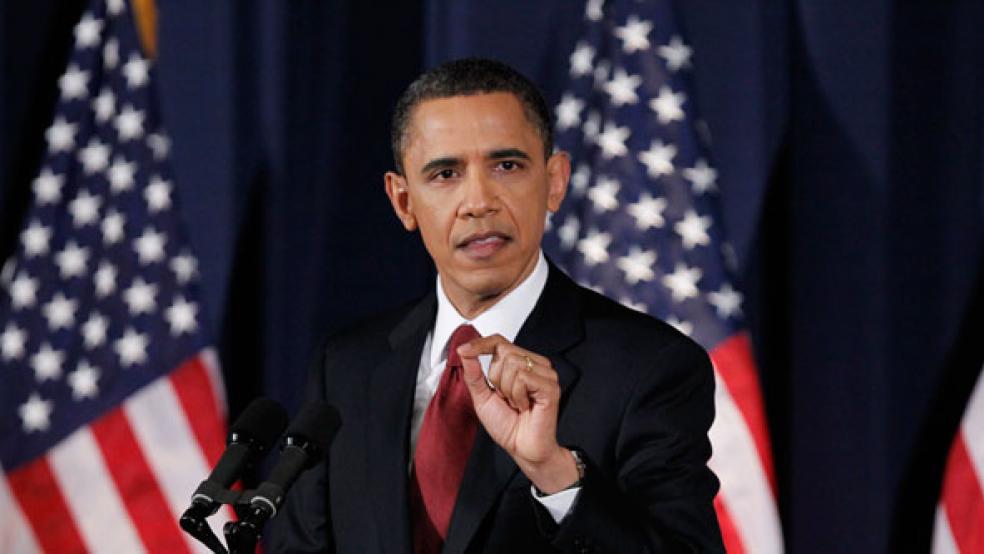As President Obama delivers his State of the Union address tonight, it’s clear that the U.S. economy is as strong as it’s been in years. Rather than having to try to convince Americans that things might have been worse if not for his policies, the president will be able to point to some significant signs of progress — leaving aside any question of just how much credit he (or any president) should or shouldn’t get for the developments in a massive and complex economy.
Obama has already been touting the economic gains. “So the good news is the economy has picked up speed,” he said in a speech last week urging Congress to require employers to give workers seven paid sick days a year. “We are past the point of crisis. We've seen 58 straight months of job growth. We have seen 11 million jobs created. The economy is stable and is building momentum. Now we have to make sure that that economy is benefitting everybody.”
Related: Sorry, Mitch — Americans Give Obama Credit for Economy
That, as you’ll see in the charts below, remains a serious challenge, and will be the subject of great policy debates as Democrats and Republicans look ahead to the 2016 elections. With that in mind, here’s a look at where the U.S. economy stands:
After many fits and starts since the financial crisis, the economy has recently been growing at its fastest rate in more than a decade. Inflation-adjusted gross domestic product increased at a seasonally adjusted annual rate of 5 percent in the third quarter of 2014, the best quarterly growth since 2003. That followed 4.6 percent annualized growth in the second quarter, offering hope that the recovery is finally gaining traction.
Economists expect that the first read on fourth-quarter growth, due from the Bureau of Economic Analysis on Jan. 30, will show a slight deceleration. Macroeconomic Advisers is forecasting 3.2 percent GDP growth for the last three months of 2014 and a 2.5 percent for the first three months of this year. For the full year, it looks like we might finally move past the tepid 2 percent growth of recent years (or, to be more precise: 2.5 percent, 1.6 percent, 2.3 percent and 2.2 percent in the four years through 2013).
“The US economy is likely to grow about 3 percent next year, almost 1 percentage point above potential,” Goldman Sachs Chief Economist Jan Hatzius wrote recently. “The key reason for optimism on growth is that the domestic strengths of the U.S. economy should outweigh the potential drag from weakness in global demand and the appreciation of the U.S. dollar.”
A strengthening job market and falling gas prices are adding to the optimism surrounding U.S. consumers. Unemployment has fallen to 5.6 percent, the lowest since June 2008, as employers added 2.95 million jobs in 2014, the most in any year since 1999. December was the 11th straight month in which payrolls grew by 200,000 or more, the longest such streak in almost 20 years.
As Hatzius and other economists note, falling oil and gas prices should help make consumers feel at least a bit more flush, and boost spending in the months ahead. “Solid growth in the near term is supported by falling energy prices that boost real incomes and wealth, large increases in household net worth in recent years, solid gains in employment, improving sentiment, and low interest rates,” economists at Macroeconomic Advisers wrote in a report last week.
The "large increases in household net worth" have been driven by a booming stock market and a recovering, albeit not quite booming, housing market.
So the good times are back, right? Well, certainly not for everyone. The Great Recession and its aftermath left millions of Americans on the sidelines of the labor market, and the improving labor market has not drawn them back. The labor force participation rate dropped to 62.7 percent as of December, a 35-year low.
Normally, a tighter job market would lead to stronger wage growth, but that hasn’t happened yet. Average hourly earnings rose just 1.7 percent from December 2013 to December 2014, and wages overall have been stagnant for more than a decade. Inflation-adjusted median household income is now at the same level it was in the mid-1990s.
Related: Why Democrats Are Pushing a $1.2 Trillion Redistribution of Wealth
The Employment Cost Index calculated by the Bureau of Labor Statistics, which looks at the price of workers including wages and benefits, grew somewhat more strongly over the second and third quarters of 2014. Still, economists are waiting for workers to start getting fatter paychecks and it hasn’t really happened. That might be because of all those potential workers who are not in the job market but could be, or other factors could be involved.
This is where the political debate will now center, at least to the extent that Obama and his State of the Union can set the agenda: How does the U.S. address that income stagnation and help more Americans feel the benefits of a better economy? Obama’s will outline his answer tonight, though many of his proposals aren't likely to become much more than that over the next two years. Republicans, meanwhile, are likely to come up with a very different set of responses. And the 2016 election suddenly seems that much closer at hand.
Top Reads from The Fiscal Times:





